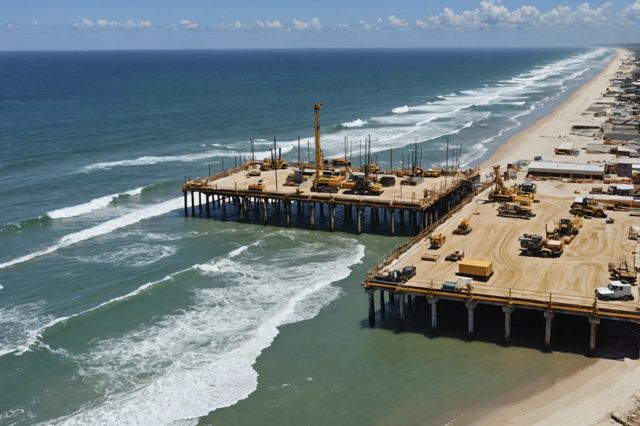Oceanfront foundation fixes often involve elevating structures on pilings or using resistant materials to combat erosion and saltwater corrosion. Regular maintenance and adherence to local building codes are crucial for long-term stability.
Introduction to Oceanfront Foundation Challenges
Oceanfront construction presents unique challenges not found in other types of building. The longevity and resilience of foundations here are key, thanks to the severe environmental conditions that can occur. Storm surges, erosion, high-velocity waves, and floodborne debris are just some of the risks that pose a threat to these foundations. Their location also exposes them to more intense weathering and corrosion effects.
Designing foundations for such conditions involves navigating particular issues. These include dealing with a range of environmental forces and sticking to building codes that have less established guidance for these circumstances. For example, the Federal Emergency Management Agency (FEMA) gives several handbooks and documents such as FEMA 550 and 499 to assist in the design and build of these foundations. The American Society for Civil Engineers (ASCE) also sets specific standards through ASCE 24 for building in flood zones.
Building codes, like those from the International Building Code (IBC), demand that specific local flood conditions and elevations be specified in construction documents for homes located in Special Flood Hazard Areas (SFHA). The National Flood Insurance Program (NFIP) distinguishes flood risk by zones, with Zone A and Zone V seen as high-risk coastal areas. There’s even a specific Coastal Zone A category for structures facing waves up to 1.5 feet high.
The design of these foundations often requires one to raise the building. Piers, pilings, or columns can be used to lower flood risks. The design needs to strike a balance between structural integrity and accessibility while meeting the expectations of the Americans with Disabilities Act (ADA).
Local expertise is key in understanding the challenges of the flood-zones. Familiarity with historical data and trends is important for foundation design. For more comprehensive instruction, designers and builders can refer to FEMA’s Coastal Construction Manual (FEMA P-55). This covers hazard identification, risk management, and the detailed design, construction, and maintenance of coastal buildings.
In conclusion, construction foundations in coastal areas need exceptional planning and robust construction to withstand the environmental pressure they face. Regulations and standards from FEMA and ASCE play an integral role in guiding this process.

Common Oceanfront Foundation Problems
Oceanfront properties face unique foundational challenges. High impacts from storms, waves, and debris threaten the integrity of these structures. Other issues include:
- Erosion: This process gradually removes soil from the property, impacting foundation stability.
- Saltwater corrosion: Oceanside structures are exposed to salt spray, which can cause corrosion and weaken building materials.
- Foundation settling: Over time, foundations can sink or settle into the ground unevenly, leading to structural problems.
To tackle these complications, understanding the local environment and historical data is required. It’s essential that construction meets specific codes and standards to ensure safety. For instance, the Foundation Emergency Management Agency (FEMA) offers guidelines like FEMA 550 and 499 to help in coastal foundation design. Similarly, the American Society for Civil Engineers (ASCE) has standards for building in flood zones.
One key requirement is specifying local flood conditions and elevations in construction documents, particularly for homes in Special Flood Hazard Areas (SFHA). This is mandated by the International Building Code (IBC). It’s worth noting that the National Flood Insurance Program (NFIP) classifies Zone A and Zone V as high-risk coastal areas.
Addressing these challenges involves elevation through methods like pilings, piers, or columns. These techniques help to mitigate flood risks. Yet, there’s also a need to balance between maintaining structural integrity and accessibility, with considerations for the Americans with Disabilities Act (ADA).
Remember, the design, construction, and maintenance of coastal buildings require thorough planning and robust construction methods. This helps to ensure the building can withstand environmental forces. FEMA’s Coastal Construction Manual (FEMA P-55) provides complete guidance on managing risks and identifying hazards.
Techniques for Oceanfront Foundation Repair
Coastal foundations face unique challenges due to environmental factors such as storm surge, erosion, high-velocity waves, and floodborne debris. To counter these difficulties, several technologies and methods are applied. Among the most effective strategies:
- Erecting structures on pilings, or large stakes driven into the ground. This technique not only elevates the building above potential floodwaters, but also adds stability against strong coastal winds.
- Using resistant materials for construction. The exposure to saltwater and high wind speeds necessitates specially treated or naturally resistant materials to help structures withstand the environmental impact.
- Implementing underpinning techniques. This process involves strengthening an existing foundation by extending it deeper or wider into the ground, helping to distribute the load and add integrity to the structure.
Understanding local building codes is a key aspect of oceanfront foundation fixes. For instance, FEMA and the American Society for Civil Engineers provide numerous standards and guidelines for constructing in coastal areas. These guidelines include FEMA 550 and 499 and ASCE 24. Many areas also rely on the International Building Code, which requires detail about local flood conditions in construction documentations.
Adherence to these codes and standards can significantly improve the durability and resilience of oceanfront foundations. Yet, even the most robust foundations require careful planning and ongoing maintenance to promote longevity and safety in the face of coastal conditions and potential climate change impacts.
By combining knowledge of the local area, compliance with regulations, innovative techniques, and robust materials, it is possible to facilitate reliable and resilient oceanfront foundation repairs.

Preventative Measures for Long-Term Stability
Oceanfront properties face unique challenges compared to inland structures due to environmental factors such as storm surges, erosion, high-velocity waves, and floodborne debris. These elements can significantly affect the long-term stability of the foundation. Therefore, thoughtful design considerations, material selection, and regular maintenance practices are imperative.
Designing coastal foundations involves mitigating various environmental forces and adhering to established building codes specific to marine environments. The Federal Emergency Management Agency (FEMA) provides guidelines through documents such as FEMA 550 and 499, while the American Society for Civil Engineers (ASCE) provides specific standards through ASCE 24 for building in flood zones. Key elements to consider in design include:
- Local flood conditions and elevations, which must be specified in construction documents for homes in Special Flood Hazard Areas (SFHA).
- Elevating the building using methods like piers, pilings, or columns to minimize flood risks.
- Balancing structural integrity and accessibility, especially in compliance with the Americans with Disabilities Act (ADA).
Material selection plays a considerable role in building a resilient coastal foundation. From wall and roof sheathing, siding, roofing, doors, and windows, every component must be chosen mindful of extreme weather conditions, particularly in hurricane-prone areas, to protect against high winds and flying debris.
Maintenance practices should be proactive and include regular checks on the structural integrity of the property, especially after major weather events. An experienced local contractor can account for historical data and trends, contributing to keeping your property resilient and long-lasting.
Finally, should any substantial damage occur, Foundation Builders can assist with comprehensive foundation repair or replacement services. Take active steps to protect and maintain the foundation of your oceanfront property. Don’t wait for issues to surface before seeking professional help. Consult experienced professionals at Foundation Builders for a free foundation inspection today.

Sources
The article “Oceanfront Foundation Fixes” used information from the following sources:
FAQ
What are the common challenges faced by oceanfront foundations?
Oceanfront foundations face challenges like storm surges, erosion, high-velocity waves, and floodborne debris. These environmental factors cause issues such as soil erosion, saltwater corrosion, and foundation settling.
How does erosion impact oceanfront foundations?
Erosion gradually removes soil from the property, affecting the stability of the foundation. This can lead to uneven settling and structural problems over time.
What is saltwater corrosion, and how does it affect buildings?
Saltwater corrosion occurs when structures are exposed to salt spray from the ocean. This can weaken building materials and reduce the overall integrity of the structure.
What are some techniques used to repair oceanfront foundations?
Techniques include erecting structures on pilings, using resistant materials, and implementing underpinning methods. These strategies help elevate buildings above floodwaters and add stability against coastal winds.
What guidelines and standards should be followed for oceanfront foundation construction?
Guidelines from FEMA, such as FEMA 550 and 499, and standards from the American Society for Civil Engineers (ASCE) like ASCE 24, should be followed. The International Building Code (IBC) also requires detailed information about local flood conditions in construction documents.
Why is local expertise important in oceanfront foundation construction?
Local expertise is crucial for understanding the specific challenges of flood zones. Familiarity with historical data and trends helps in designing foundations that can withstand local environmental conditions.
How can elevating a building help in oceanfront areas?
Elevating a building using methods like piers, pilings, or columns can help reduce flood risks. This technique also aids in maintaining structural integrity and accessibility.
What role does material selection play in the durability of oceanfront foundations?
Choosing resistant materials for construction is essential for withstanding extreme weather conditions, particularly in hurricane-prone areas. This includes selecting appropriate wall and roof sheathing, siding, roofing, doors, and windows.
What are some preventative measures for maintaining the stability of oceanfront foundations?
Preventative measures include thoughtful design considerations, regular maintenance practices, and proactive checks on structural integrity, especially after major weather events. Consulting with experienced local contractors can also help in maintaining long-term stability.

